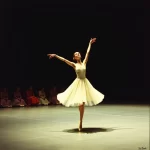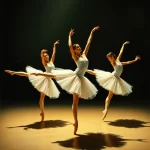Ballet: Le Sacre du printemps (The Rite of Spring) (Pina Bausch, 1975)

Introduction
Ballet, as an art form, has seen numerous groundbreaking works that have pushed the boundaries of dance and storytelling. One such work is “Le Sacre du printemps” (The Rite of Spring), choreographed by Pina Bausch in 1975. This ballet, set to the music of Igor Stravinsky, premiered on June 3, 1975, and has since become a seminal piece in the world of contemporary dance. The ballet’s plot revolves around ancient pagan rituals, culminating in a sacrificial dance that heralds the arrival of spring.
Historical Background
Creation and Development
“Le Sacre du printemps” was created in a period marked by significant social and artistic upheaval. The original version, choreographed by Vaslav Nijinsky and premiered in 1913, was a radical departure from traditional ballet, both in its music and choreography. Pina Bausch’s 1975 interpretation came at a time when contemporary dance was gaining prominence, influenced by the avant-garde movements of the 20th century.
The inspiration behind the ballet lies in Slavic folklore and ancient rituals. Stravinsky’s score, with its complex rhythms and dissonant harmonies, was revolutionary and perfectly suited the raw, primal energy that Bausch sought to capture in her choreography. The collaboration between Bausch and Stravinsky, though separated by time, resulted in a powerful synergy that brought the ancient rites to life on stage.
Premiere and Reception
The premiere of Pina Bausch’s “Le Sacre du printemps” took place on June 3, 1975, at the Wuppertal Opera House in Germany. The initial reception was mixed, with some critics praising the boldness and intensity of the performance, while others found it too jarring and unconventional. However, as the ballet was performed more widely, it gained recognition for its innovative choreography and emotional depth.
Notable early performances included revivals in major cities across Europe and North America, where it continued to challenge and captivate audiences. Over time, Bausch’s interpretation of “Le Sacre du printemps” has become a cornerstone of contemporary dance, celebrated for its raw power and artistic vision.
Synopsis of the Ballet
“Le Sacre du printemps” is a one-act ballet that unfolds in a series of scenes depicting ancient pagan rituals. The narrative is non-linear, focusing more on the emotional and physical intensity of the dances rather than a traditional storyline.
Key Moments
- The Augurs of Spring: The ballet opens with a group of dancers performing a series of frenzied movements, symbolizing the awakening of nature and the arrival of spring.
- The Ritual of Abduction: A young girl is chosen as the sacrificial victim, and the community performs a ritualistic dance around her.
- The Sacrificial Dance: The climax of the ballet, where the chosen girl dances herself to death, offering her life to ensure the renewal of the earth.
Musical Composition
Composer’s Role
Igor Stravinsky, the composer of “Le Sacre du printemps,” played a crucial role in shaping the ballet’s identity. His score, characterized by its complex rhythms, dissonant harmonies, and innovative orchestration, was groundbreaking at the time of its creation. Stravinsky’s music not only provided the foundation for the choreography but also enhanced the narrative and emotional impact of the ballet.
Musical Themes and Motifs
The score of “Le Sacre du printemps” is rich with recurring themes and motifs that underscore the ballet’s primal energy. The use of irregular rhythms and abrupt changes in tempo mirrors the unpredictability of nature and the intensity of the rituals depicted on stage. Leitmotifs associated with specific characters or actions help to create a cohesive musical narrative that complements the choreography.
Famous Recordings and Performances
Several iconic recordings of Stravinsky’s score have been made over the years, with notable performances by orchestras such as the London Symphony Orchestra and the Berlin Philharmonic. These recordings have helped to cement the ballet’s place in the classical music canon and have been used in numerous productions of the ballet worldwide.
Choreography and Dance
Choreographer’s Vision
Pina Bausch’s vision for “Le Sacre du printemps” was to create a visceral, emotionally charged experience that captured the raw power of the ancient rituals depicted in the ballet. Her choreography is characterized by its intense physicality, with movements that are both primal and precise. Bausch’s innovative use of space and group dynamics helped to create a sense of communal energy and tension that is central to the ballet’s impact.
Signature Dance Numbers
- The Augurs of Spring: This opening dance sets the tone for the entire ballet, with its frenetic energy and complex group formations.
- The Sacrificial Dance: The climax of the ballet, where the chosen girl performs a solo dance that is both physically demanding and emotionally devastating.
Notable Interpretations
Over the years, different productions of “Le Sacre du printemps” have brought their own interpretations to Bausch’s choreography. Some have emphasized the ritualistic aspects of the ballet, while others have focused on the psychological and emotional journey of the characters. These varied interpretations have helped to keep the ballet fresh and relevant, allowing it to resonate with new audiences.
Characters and Roles
Main Characters
- The Chosen One: The central character of the ballet, a young girl selected as the sacrificial victim. Her journey from innocence to sacrifice is the emotional core of the ballet.
Supporting Characters
- The Community: A group of dancers who represent the ancient tribe performing the rituals. Their movements and interactions create a sense of communal energy and tension.
Famous Dancers
Over the years, many notable dancers have taken on the challenging role of the Chosen One, including Pina Bausch herself. Other renowned performers include Marie-Claude Pietragalla and Sylvie Guillem, who have brought their own unique interpretations to the role.
Cultural and Artistic Impact
Influence on Ballet and Dance
“Le Sacre du printemps” has had a profound influence on the world of ballet and contemporary dance. Its innovative choreography and powerful music have inspired countless choreographers and dancers, pushing the boundaries of what is possible in dance. The ballet’s emphasis on raw emotion and physicality has also helped to pave the way for more experimental and avant-garde works.
Cultural Significance
The ballet’s impact extends beyond the world of dance, with references and adaptations appearing in various forms of popular culture, literature, and media. Its themes of sacrifice and renewal resonate with audiences on a deep, primal level, making it a timeless work that continues to captivate and inspire.
Legacy and Revivals
Over the years, “Le Sacre du printemps” has been revived and reinterpreted by numerous dance companies and choreographers. These revivals have helped to keep the ballet alive and relevant, allowing new generations to experience its power and beauty. The ballet’s legacy is also evident in the many works it has inspired, both within and outside the world of dance.
Iconic Productions
Historic Productions
Some of the most famous historical productions of “Le Sacre du printemps” include the original 1913 premiere by the Ballets Russes, choreographed by Vaslav Nijinsky, and Pina Bausch’s 1975 interpretation. These productions were groundbreaking in their own right, pushing the boundaries of dance and challenging audiences’ expectations.
Contemporary Productions
Recent productions of “Le Sacre du printemps” have continued to explore new interpretations and approaches to the ballet. Companies such as the Paris Opera Ballet and the Royal Ballet have staged their own versions, incorporating modern elements and innovative choreography while staying true to the spirit of the original work.
Production Design
The set, costume, and lighting design of “Le Sacre du printemps” play a crucial role in creating the ballet’s atmosphere and enhancing its emotional impact. Different productions have taken various approaches to these elements, from minimalist designs that focus on the dancers’ movements to elaborate sets that evoke the ancient rituals depicted in the ballet.
Critical Reception and Reviews
Initial Critical Response
The initial critical response to Pina Bausch’s “Le Sacre du printemps” was mixed, with some critics praising its boldness and intensity, while others found it too unconventional. However, as the ballet was performed more widely, it gained recognition for its innovative choreography and emotional depth.
Modern Reviews
Contemporary critics and audiences continue to be captivated by “Le Sacre du printemps,” praising its raw power and artistic vision. The ballet’s themes of sacrifice and renewal resonate with modern audiences, making it a timeless work that remains relevant and impactful.
Fun Facts and Trivia
Behind-the-Scenes Stories
One interesting anecdote from the production of “Le Sacre du printemps” involves the use of real soil on stage. Pina Bausch insisted on this element to create a more authentic and visceral experience for the dancers and audience. This decision added an extra layer of physicality to the performance, as the dancers had to navigate the uneven terrain while executing their complex movements.
Notable Performers
Over the years, many famous dancers have been associated with “Le Sacre du printemps,” including Pina Bausch herself, who performed in the original 1975 production. Other notable performers include Marie-Claude Pietragalla and Sylvie Guillem, who have brought their own unique interpretations to the role of the Chosen One.
Trivia
- The original 1913 premiere of “Le Sacre du printemps” caused a riot in the audience due to its unconventional music and choreography.
- Pina Bausch’s 1975 interpretation is considered one of the most influential contemporary dance works of the 20th century.
- The ballet’s score by Igor Stravinsky is one of the most frequently performed and recorded works in the classical music repertoire.
Conclusion
Summary of the Ballet’s Importance
“Le Sacre du printemps” is a landmark work in the world of ballet and contemporary dance. Its innovative choreography, powerful music, and emotional depth have made it a timeless work that continues to captivate and inspire audiences. The ballet’s themes of sacrifice and renewal resonate on a deep, primal level, making it a work of enduring significance.
Final Thoughts
Reflecting on “Le Sacre du printemps,” it is clear that this ballet is more than just a performance; it is an experience that challenges and moves its audience. Pina Bausch’s interpretation has left an indelible mark on the world of dance, pushing the boundaries of what is possible and inspiring countless artists. For those who have not yet experienced this powerful work, it is highly recommended to watch a performance or listen to Stravinsky’s groundbreaking score.
FAQ
What is the central theme of this ballet?
The central theme of “Le Sacre du printemps” is the ancient pagan ritual of sacrifice to ensure the renewal of spring.
Who are the main characters in this ballet?
The main character is the Chosen One, a young girl selected as the sacrificial victim. The supporting characters include the community of dancers who perform the rituals.
What is the most famous dance number in this ballet?
The most famous dance number is the Sacrificial Dance, where the Chosen One performs a solo dance that is both physically demanding and emotionally devastating.
How long does a typical performance of this ballet last?
A typical performance of “Le Sacre du printemps” lasts approximately 35-40 minutes.
Are there any modern adaptations of this ballet?
Yes, there have been numerous modern adaptations and reinterpretations of “Le Sacre du printemps” by various dance companies and choreographers.
Why is this ballet considered important in the history of dance?
“Le Sacre du printemps” is considered important in the history of dance due to its innovative choreography, groundbreaking music, and its influence on subsequent works in both ballet and contemporary dance.





